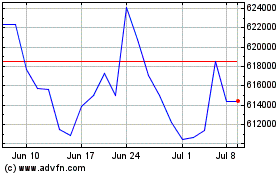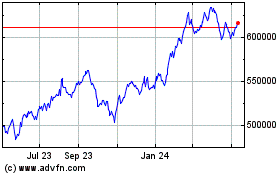By Liz Hoffman and Ryan Tracy
Big U.S. banks plan to increase dividend payouts and share
buybacks to their highest levels in years after the Federal Reserve
on Wednesday approved capital plans for all 34 firms taking part in
its annual stress tests.
The approvals -- the first time since the annual tests began in
2011 that all firms got passing grades -- reflect a turning point
for big financial institutions that have been shackled by tighter
regulation since the financial crisis. They could also herald a
return to precrisis days when banks were reliable dividend payers
and shareholders flocked to them.
Bank of America Corp., for example, said that it would increase
its dividend by 60% to 12 cents a share per quarter, putting it
above a threshold where Warren Buffett's Berkshire Hathaway Inc.
may convert a stake in the firm into common stock and become the
bank's largest shareholder. The second-biggest U.S. bank by assets
also said it received approval to repurchase up to $12.9 billion of
its shares, far above the $7.7 billion it bought back over the
previous year.
On average, the group of firms taking part in the stress tests
requested payouts that are near 100% of their expected earnings
over the next year, up from 65% last year, senior Fed officials
said. That means banks in some cases will be able to start
whittling away at capital buffers that many bank executives say are
well in excess of what is needed to absorb potential losses.
Such moves signal an easing of the Fed's hardline stance toward
banks since the crisis and could provide a durable pillar of
support for higher bank stock prices. Those soared following
President Donald Trump's election but largely have treaded water so
far in 2017 amid lackluster economic indicators, political defeats
for the White House and a flattening yield curve that threatens to
weigh on bank profits.
The KBW Nasdaq Bank index is up 2.8% year to date versus an 8.9%
gain for the S&P 500. That said, bank stocks are still well
ahead of the broader market when measured from November's election.
Big-bank shares rose in many cases more than 1% in after-hours
trading Wednesday, while some, like Citigroup Inc., were up more
than 2%.
The payouts announced by banks following the tests' release
Wednesday were in many cases above what investors had expected.
Citigroup, for instance, said it planned to return $18.9 billion
to shareholders over the coming four quarters. That is equal to
132% of what Wall Street analysts expect the bank to earn over the
same period. Analysts had expected the bank's payout ratio would be
around 110%.
Morgan Stanley and Alabama-based Regions Financial Corp. were
also among those that were approved for payout ratios in excess of
100%, according to FactSet estimates and Wall Street Journal
reviews of corporate filings.
"The absolute minimum is there won't be increased capital in
these businesses," Morgan Stanley Chief Executive James Gorman said
earlier this month. "There shouldn't be and there won't be."
Morgan Stanley, Goldman Sachs Group Inc. and State Street Corp.
cleared one of the Fed's yardsticks by just tenths of a percentage
point, suggesting they have gotten more adept at figuring out how
to squeak through the tests.
The latest result was the second part of the Fed's test results.
In the first leg, released last week, the Fed said all big U.S.
banks were able to survive a hypothetical recession.
Fed governor Jerome Powell said the stress-test process, now in
its seventh year, "has motivated all of the largest banks to
achieve healthy capital levels."
Born of the financial meltdown, the stress tests have come to
command bankers' and investors' attention each year. Executives
manage with the tests in mind and have collectively spent billions
of dollars to develop risk-management systems to meet the Fed's
expectations.
This year's passing grades suggest that those efforts have paid
off. Banks today are better capitalized and more conservatively
managed than in the years before the financial crisis and have
better insight into risks lurking in their own books.
J.P. Morgan Chase & Co., the nation's biggest bank by
assets, was approved for a 12% increase to its dividend and a $19.4
billion buyback program. CEO James Dimon said the bank was "pleased
to further increase capital returns to our shareholders while
continuing to invest in our businesses."
In a nod to progress at banks, the Fed has made changes to the
exams. This year, only 13 of the biggest, most complex banks faced
a qualitative exam of their risk-management abilities. Others, such
as the U.S. arm of Spain's Banco Santander SA, had to pass only a
numerical assessment.
The results had some banks breathing sighs of relief. At
Santander, the U.S. chief executive said he planned to hold a
champagne toast in the boardroom after the Fed approved its capital
plan. The bank had failed the tests the previous three years.
Wells Fargo & Co.'s approval, too, is a sorely needed win
for the bank, which has been in the spotlight for months over a
sales-practices scandal. Some analysts had predicted that the Fed
might flunk Wells Fargo on "qualitative" grounds even if it passed
the numerical part of the exam.
Wells Fargo Chief Financial Officer John Shrewsberry said this
spring that the bank was "very self-aware" of that risk and that it
had "sized our [capital-return] ask appropriately."
The Fed said the largest and most complex firms, however, still
have work to do in maintaining accurate data and identifying risks
in new products.
One spot hit hard this year was credit cards. Credit-card
defaults are rising after years in record-low territory and were a
chief focus of Fed officials who designed this year's tests. Last
week's results forecast $100 billion of credit-card losses in a
severe downturn across the industry.
Two of the largest standalone card issuers, Capital One
Financial Corp. and American Express Co., revised their payout
requests downward after receiving the results of the stress test's
first part last week.
The Fed approved Capital One's plan, but only contingent on the
firm resubmitting it within six months to address what the
regulator called "material weaknesses."
The bank is "fully committed to addressing the Federal Reserve's
concerns with our capital planning process in a timely manner."
Richard Fairbank, Capital One chief executive, said in a
statement.
Some executives still say the Fed's process is overly opaque and
stringent and have complained that the higher capital required by
them has choked lending and harmed the economy.
The Trump administration has been sympathetic to bankers'
complaints and recently recommended changes to the tests.
--Christina Rexrode contributed to this article.
Write to Liz Hoffman at liz.hoffman@wsj.com and Ryan Tracy at
ryan.tracy@wsj.com
(END) Dow Jones Newswires
June 28, 2017 19:55 ET (23:55 GMT)
Copyright (c) 2017 Dow Jones & Company, Inc.
Berkshire Hathaway (NYSE:BRK.A)
Historical Stock Chart
From Mar 2024 to Apr 2024

Berkshire Hathaway (NYSE:BRK.A)
Historical Stock Chart
From Apr 2023 to Apr 2024
